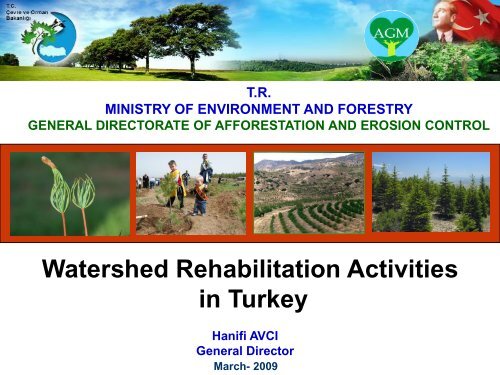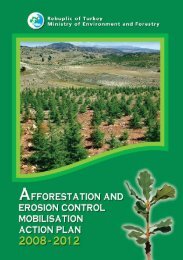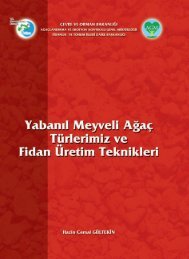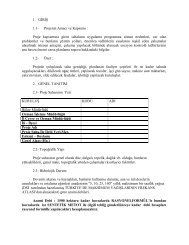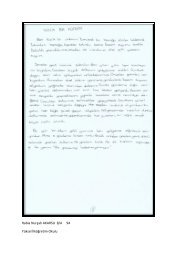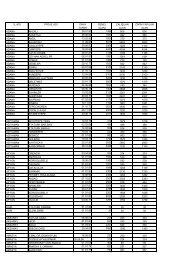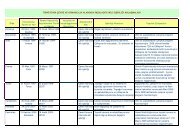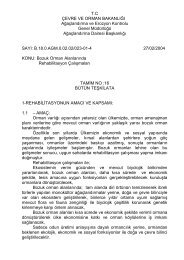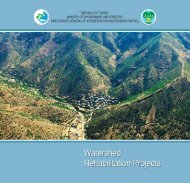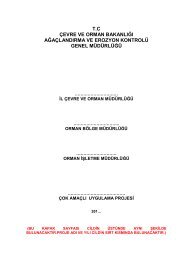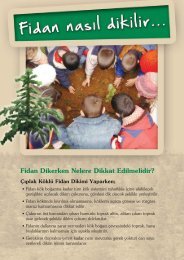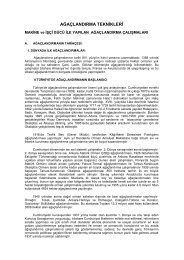Integrated Watershed Rehabilitation Activities
Integrated Watershed Rehabilitation Activities
Integrated Watershed Rehabilitation Activities
- No tags were found...
You also want an ePaper? Increase the reach of your titles
YUMPU automatically turns print PDFs into web optimized ePapers that Google loves.
T.R.MINISTRY OF ENVIRONMENT AND FORESTRYGENERAL DIRECTORATE OF AFFORESTATION AND EROSION CONTROL<strong>Watershed</strong> <strong>Rehabilitation</strong> <strong>Activities</strong>in TurkeyHanifi AVCIGeneral DirectorMarch- 2009
Overall Situation• In the watersheds of Turkey; apart from the naturalerosion deriving from climate, topography andgeological structure; an accelerated type of erosionis present due to incorrect land practices andexcessive use of land.• The most important reason for destruction of naturalresources in the watersheds is rural poverty. Peoplehave to use natural resources in order to continuetheir living. Hence, this situation leads to furtherdestruction and greater poverty; and this viciouscycle continues on and on.
<strong>Watershed</strong> <strong>Activities</strong> in Turkey<strong>Watershed</strong> rehabilitation works in 1950s wereintroduced with the aim of decreasing the damages offloods and overflows and thereby providing safety forcurrent dams.First implementations in the upper watersheds werereduction of soil erosion, facilities and afforestationworks regulating water flow regime.
<strong>Watershed</strong> <strong>Activities</strong> in TurkeyIn the meanwhile, various supports were provided to thewatershed local communities by conservation of naturalvegetation cover and regulating grazing at rangelands.Preventions for increasing isolation in the houses weredeveloped in order to decrease wood consumption.Forest Organisation realised many projects all overTurkey aimed at soil conservation and erosion controland these projects are continued.
<strong>Integrated</strong> <strong>Watershed</strong> <strong>Rehabilitation</strong> <strong>Activities</strong>• Since the watershed activities are in the scope andduty of many state organisations and it is importantto include local community and nongovernmentalorganisations for a sustainable natural resourcemanagement; “integrated watershed managementprojects” were made essential.
<strong>Integrated</strong> <strong>Watershed</strong> <strong>Rehabilitation</strong> Projects in Turkey• Eastern Anatolia <strong>Watershed</strong> <strong>Rehabilitation</strong>Project• Anatolia <strong>Watershed</strong> <strong>Rehabilitation</strong> Project• Çoruh <strong>Watershed</strong> <strong>Rehabilitation</strong> ProjectMaster Plan Works• Middle East <strong>Watershed</strong> Monitoring andEvaluation Project
<strong>Integrated</strong> <strong>Watershed</strong> <strong>Rehabilitation</strong> Projects in Turkey
Main Principles of Projects• Primary objective of the projects is to stopnatural resource erosion. These projects arenot rural development projects. Ruraldistricts are supported in order to reducethe pressure on natural resources.• Participation of local community andnongovernmental organisations is essentialas well as related state agencies.Participation is sought in decision-making,implementation and project finance.
Common Aims of the ProjectsConservation, rehabilitation and management ofnatural resources (forest, soil and water)Integration of conservation, rehabilitation andmanagement of natural resource activities throughincome raising activitiesDeveloping human resourcesSustainability and generalising
First Generation <strong>Watershed</strong> <strong>Rehabilitation</strong> ProjectEastern Anatolia <strong>Watershed</strong> <strong>Rehabilitation</strong> Project:This project aimed at rehabilitation of naturalresources at the upper watersheds.Natural resource conservation and rehabilitation wastargeted and in order to reach this target, incomeraising activities to increase the living standard oflocal community as well as training the local peoplefor natural resource preservation and sustainablemanagement activities and capacity building activitiesfor the agencies were also continued.
Second Generation <strong>Watershed</strong> <strong>Rehabilitation</strong> ProjectAnatolia <strong>Watershed</strong> <strong>Rehabilitation</strong> Project:The overall watershed was taken into consideration andin the selected micro-catchments integration ofpreservation and rehabilitation of natural resources withincome raising activities are aimed at .
Anatolia <strong>Watershed</strong> <strong>Rehabilitation</strong> Project:Different from the first project;In sustainable watershed management, decreasing thepollution in surface and underground waters derivingfrom animal related activities and manure and pesticideused in agricultural activities; thereby decreasing thedrainage of nutrients into seas are aimed at.Monitoring water pollution, supporting organic farmingactivities, spreading these activities all around thecountry and providing support in implementation of EUNitrate Directive are also targeted .
Çoruh River <strong>Rehabilitation</strong> Project :It is similar to the previous projects in a differentpart of the country with different characteristics;apart from the aforementioned activities, extendingand supporting the solar energy system, which is arenewable energy source, was targeted in order toreduce consumption of fossil fuel.Furthermore; functional planning for forestlands,national park and hunting-wildlife improvements,eco-tourism planning and development are alsoincluded.
Altları çizilen 12 MHProje Uygulama Planıiçin seçilmiştir.Veliköy(BT-03)Bıçakçılar (MC-06)Şavşat (BT-04)YÜKSEK öncelikli MH’larORTA öncelikli MH’larYusufeli(MC-03)Barhal (MC-05)Olur merkez(OL-11)Olur batı (OL-12)Ispir north (UC-17)DÜŞÜK öncelikli MH’larIspir(UC-14)Şenkaya(OL-07)Taht (UC-11)Masat(UC-03)Tortum kuzey (TR-04)Tortum orta (TR-03)Tortum güney(TR-02)Uzundere (TR-06)Oltu (OL-04)Narman (OL-02)
Third Generation <strong>Watershed</strong> <strong>Rehabilitation</strong> ProjectsIn the third generation <strong>Watershed</strong> <strong>Rehabilitation</strong>Projects that are in the making, integrated watermanagement is included within the projects since theneed for water resources increases along withconservation and improvement of natural resources.The following subjects are featured: prevention ofpollution deriving from industrial and domesticwastes, water production, management and operationof upper watershed forests in line with waterproduction, planning product range according tocurrent water bodies, etc.
As a conclusion;Agricultural resources are insufficient due to rapidpopulation growth in the upper watersheds andtherefore migration to the cities increased as a resultof rural poverty. This situation has become the majorreason for many economic and social problems dueto unplanned urbanisation and unemployment.Rapid and uncontrolled growth of the cities due tomigration and over-growth of population, increase ofwater use in industry has leaded to an increase in theneed for clean water in the cities and thereby increasein the demand for new water resources.
As a conclusion;Due to excessive and uncontrolled migration from upperwatersheds to the cities, there is only elderly population inmany watersheds. Due to the fact that small water bodies,that were once used for agricultural irrigation, are nowallocated for drinking and domestic purposes andagricultural water bodies are now insufficient; the water isnow economically used and demand for modern irrigationtechniques has raised.The Experience and Development obtained in the<strong>Watershed</strong> <strong>Rehabilitation</strong> Projects that are implemented inTurkey, appear as a model to be used in similarwatersheds.


